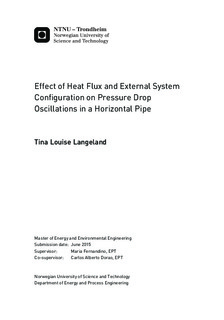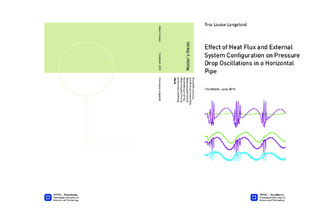| dc.description.abstract | Heat transfer processes can greatly benefit from the use of the boiling and condensation in two-phase flows. However, the use of two-phase flows may induce instabilities in the heat transfer system, causing control problems and possible damage to the equipment. Pressure Drop Oscillations (PDOs) are one of the instabilities prone to occur in convective heat transfer systems. The PDOs are characterized by oscillations of low frequency with interfering, high frequency signals known as Density Wave Oscillations (DWOs). In order to be able to control this kind of oscillations in a thermal system, a better understanding of the parameters affecting the PDOs is needed.
In this thesis, experimental work considering the effect of the external system and heat flux on the PDOs have been performed using the Two-Phase Flow Instability Facility located at the Varmeteknisk lab, EPT, NTNU. During the experiments, a single, horizontal channel of 5 mm inner diameter was used as the test section, \mbox{R134a} as the working fluid and a regulative surge tank containing nitrogen gas was used as the the compressible volume required for occurrence of PDOs.
For the external system, experimental analyses of the effect of the inlet and outlet restrictions of the heated test section, different compressible volumes and the pump bypass were conducted. It was shown that a restriction of either the inlet or outlet of the test section reduced the PDOs. Larger compressible volumes increased the PDOs, while they decreased for smaller volumes. With the use of a pump bypass, the system stabilized faster with regards to the PDOs.
Different heat fluxes applied to the test section showed that the PDOs could be regulated by both the amount and the distribution of the heat applied. For an uniform, decreasing heat flux the PDOs decreased, while for an uniform, increasing heat flux the PDOs first increased before decreasing in magnitude. Both a linear increasing and decreasing heat profile were applied to the test section. The results showed that the decreasing heat profile, generating larger amount of vapour in the test section, increased the PDOs and especially the interfering, high frequency signals. The increasing heat profile had a stabilizing effect on the system. A discussion concerning the interfering, high frequency signals that were observed to occur together with the PDOs was carried out along with experiments resulting in a conclusion that the signals may actually be another kind of oscillations than the DWOs. | |

